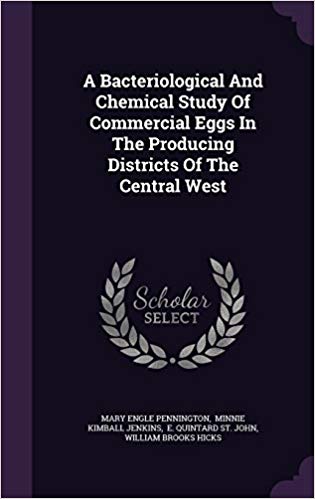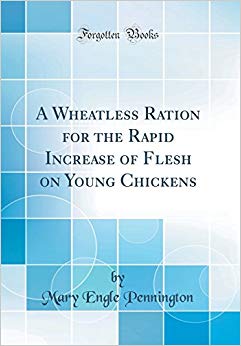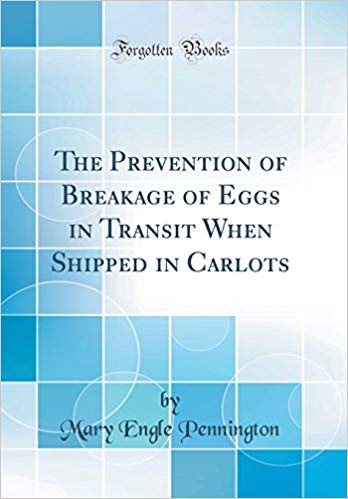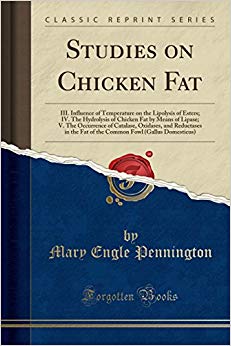Background
Pennington was born on October 8, 1872 in Nashville, Tennessee, United States; the daughter of Henry and Sarah B. (Molony) Pennington.

Philadelphia, Pennsylvania, United States
University of Pennsylvania
Philadelphia, Pennsylvania, United States
Clinical Laboratory, Women's Medical College of Pennsylvania

(This work was reproduced from the original artifact, and ...)
This work was reproduced from the original artifact, and remains as true to the original work as possible.
http://www.amazon.com/gp/product/1343246563/?tag=2022091-20
2015

(Excerpt from A Wheatless Ration for the Rapid Increase of...)
Excerpt from A Wheatless Ration for the Rapid Increase of Flesh on Young Chickens Ration A, pounds (grain, pounds). Ration B, pounds (grain, pounds). Ration C, pounds (grain, pounds). This book is a reproduction of an important historical work.
http://www.amazon.com/gp/product/0331766345/?tag=2022091-20
2017

(Excerpt from The Prevention of Breakage of Eggs in Transi...)
Excerpt from The Prevention of Breakage of Eggs in Transit When Shipped in Carlots The work here reported was begun in Texas, in March, in the early part of the carlot, shipping-season, and, gradually progressed toward the. North until September, when the investigators had reached Minnesota. The lack Of eggs made it difficult to get carlots after the middle Of September. Shipments went to eastern markets, rang ing from Pittsburgh and Buffalo on the west, to Boston on the north, anbd to Philadelphia On the south. About the Publisher Forgotten Books publishes hundreds of thousands of rare and classic books. This book is a reproduction of an important historical work.
http://www.amazon.com/gp/product/0656278900/?tag=2022091-20
2018

(Excerpt from Studies on Chicken Fat: III. Influence of Te...)
Excerpt from Studies on Chicken Fat: III. Influence of Temperature on the Lipolysis of Esters; IV. The Hydrolysis of Chicken Fat by Means of Lipase; V. The Occurrence of Catalase, Oxidases, and Reductases in the Fat of the Common Fowl (Gallus Domesticus) The greatest splitting of the esters by the lipase took place in the incubator, the least in the freezer, and between these two extremes lay the splitting in the refrigerator and in the chill room. This book is a reproduction of an important historical work.
http://www.amazon.com/gp/product/042818622X/?tag=2022091-20
2018
Pennington was born on October 8, 1872 in Nashville, Tennessee, United States; the daughter of Henry and Sarah B. (Molony) Pennington.
Pennington received a certificate of proficiency in chemistry from the University of Pennsylvania in 1892. Three years later she earned her Doctor of Philosophy degree from the same university.
Also Mary spent an additional two years at the University of Pennsylvania studying chemical botany. Pennington accepted a one-year fellowship, in 1897-1898, at Yale University, where she studied physiological chemistry, teaming with chemist Russell Chittenden to examine the effect colored light had on plant growth.
Pennington began her career as an instructor in physiological chemistry and a director of the Clinical Laboratory at Women's Medical College of Pennsylvania in 1898 and held it for eight years. She served as a research worker in the department of hygiene at the University of Pennsylvania from 1898 to 1901. Mary partnered with university colleague Elizabeth Atkinson and opened the doors to the Philadelphia Clinical Laboratory in 1901. That laboratory conducted bacteriological and chemical analyses.
Also Mary was a bacteriologist with the Philadelphia Bureau of Health, where she raised sanitation standards for the handling of milk and milk products. Then in 1905, she took a position of a bacteriological chemist for the United States Department of Agriculture. Two years later Mary was appointed a chief at Food Research Laboratory and developed standards for the processing of chickens. She was also a head of the investigation into the design of refrigerated railway boxcars and, during World War I, served on Herbert Hoover’s War Food Administration.
In 1919, Pennington left the Food Research Laboratory and moved to New York to run the research department of the American Balsa Company. Three years later she started her own business as a consultant to food storage and shipping companies, which she ran until her retirement in 1952. Mary studied frozen foods and developed improvements for commercial and home refrigeration systems. She managed to convince several major universities to incorporate courses on household refrigeration. In addition, in 1923, Pennington founded the Household Refrigeration Bureau to educate consumers in safe practices in domestic refrigeration.
She did bacteriological analyses for subscribing doctors and developed milk and dairy standards, including checklist procedures for dairy herds that were adopted throughout the United States.
Pennington is known for her contribution to the design of commercial and household refrigerators, refrigerated railway cars and freezers. Also she invented the egg carton.
She was a leading expert in the evolution of safe and sanitary methods for processing, storing and shipping milk, poultry, eggs and fish. Mary was inducted in the National Women’s Hall of Fame and the ASHRAE Hall of Fame.
(Excerpt from The Prevention of Breakage of Eggs in Transi...)
2018(Excerpt from A Wheatless Ration for the Rapid Increase of...)
2017(This work was reproduced from the original artifact, and ...)
2015(Excerpt from Studies on Chicken Fat: III. Influence of Te...)
2018Pennington was a member of the American Association for the Advancement of Science, American Society of Refrigerating Engineers, American Chemical Society, Society of Biological Chemists, American Institute of Refrigeration, Institute of Food Technological, Institute of American Poultry Industries, Poultry Science Association, Sigma Xi, Kappa Kappa Gamma and Iota Sigma Pi.
